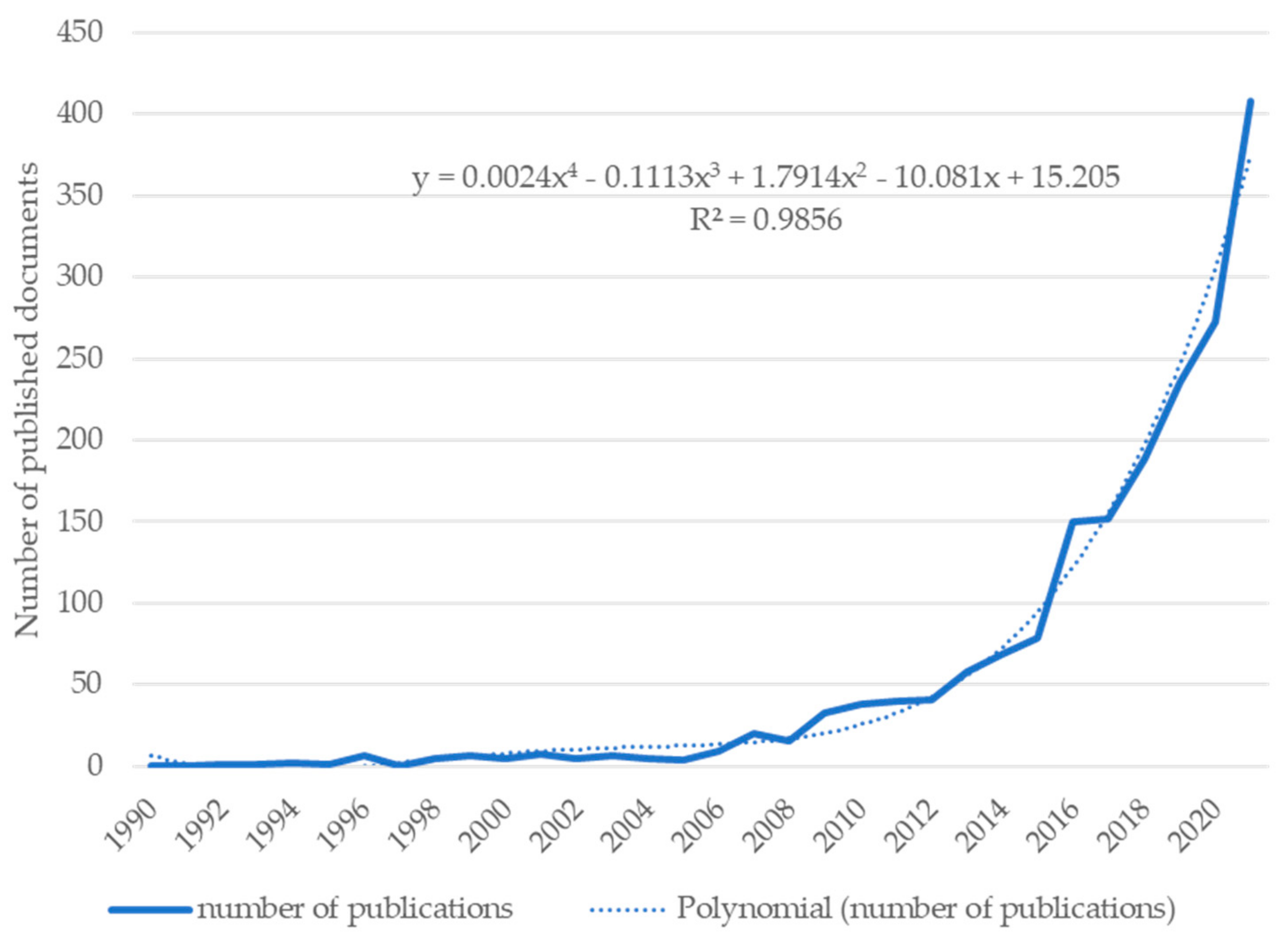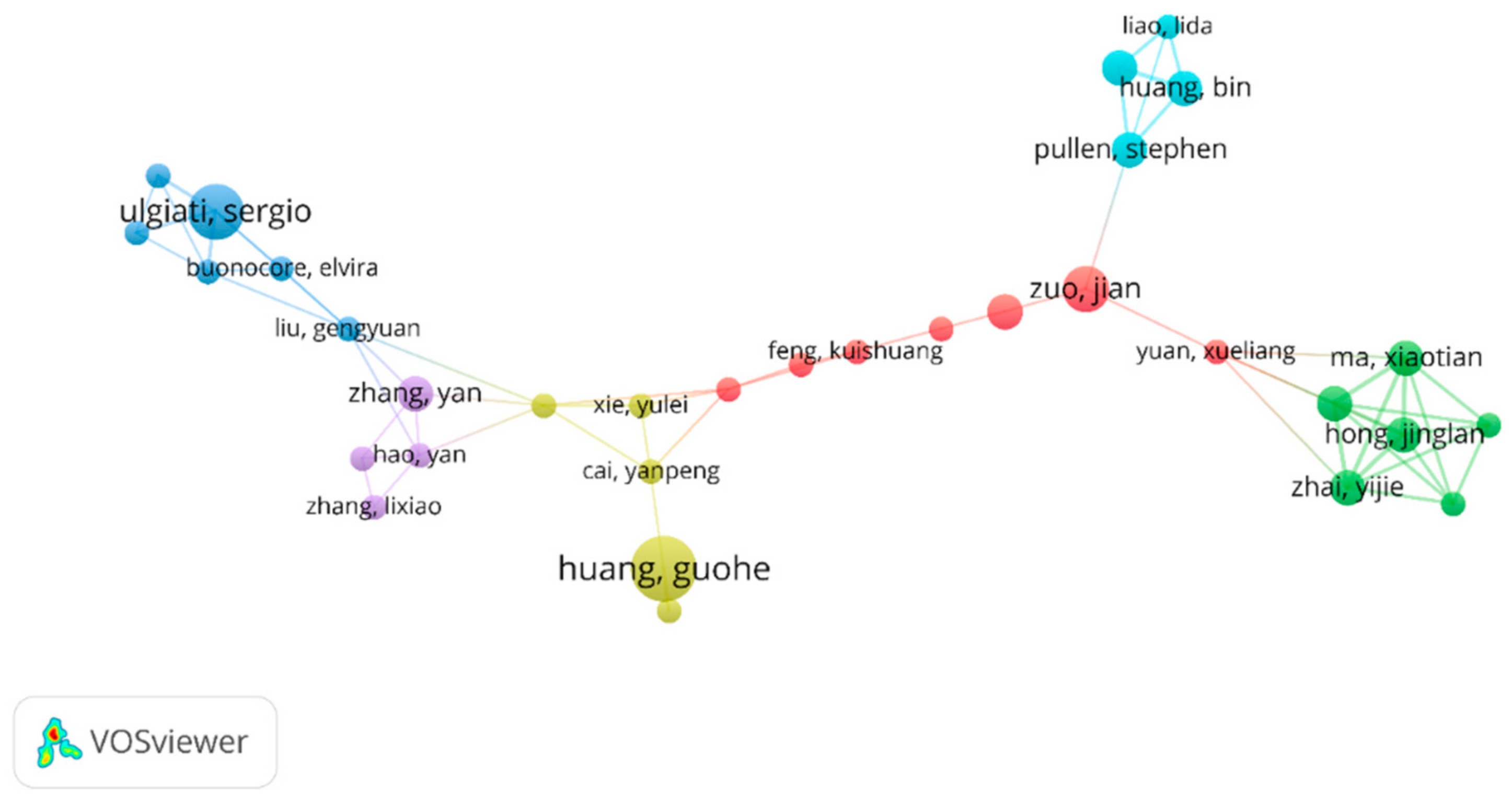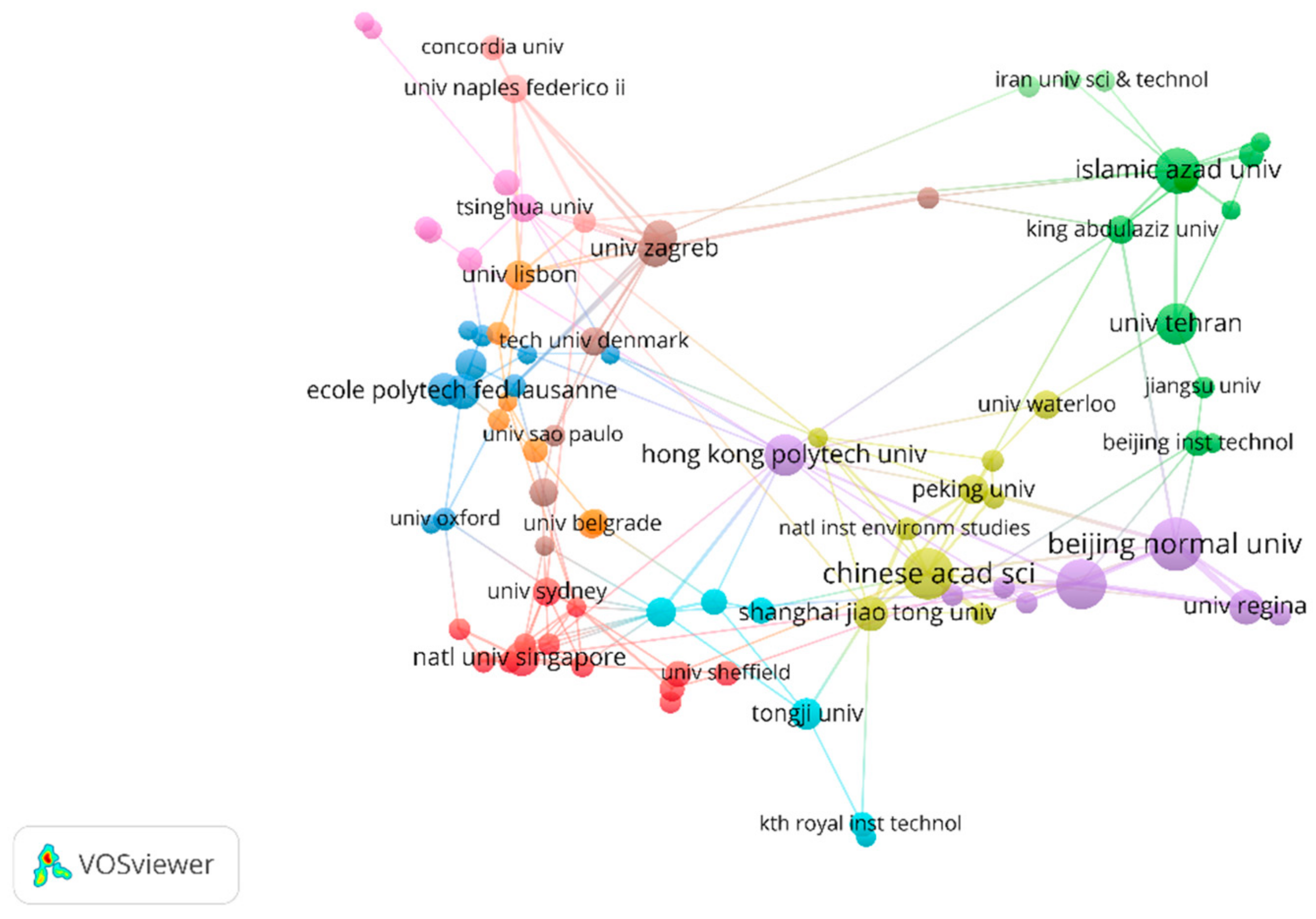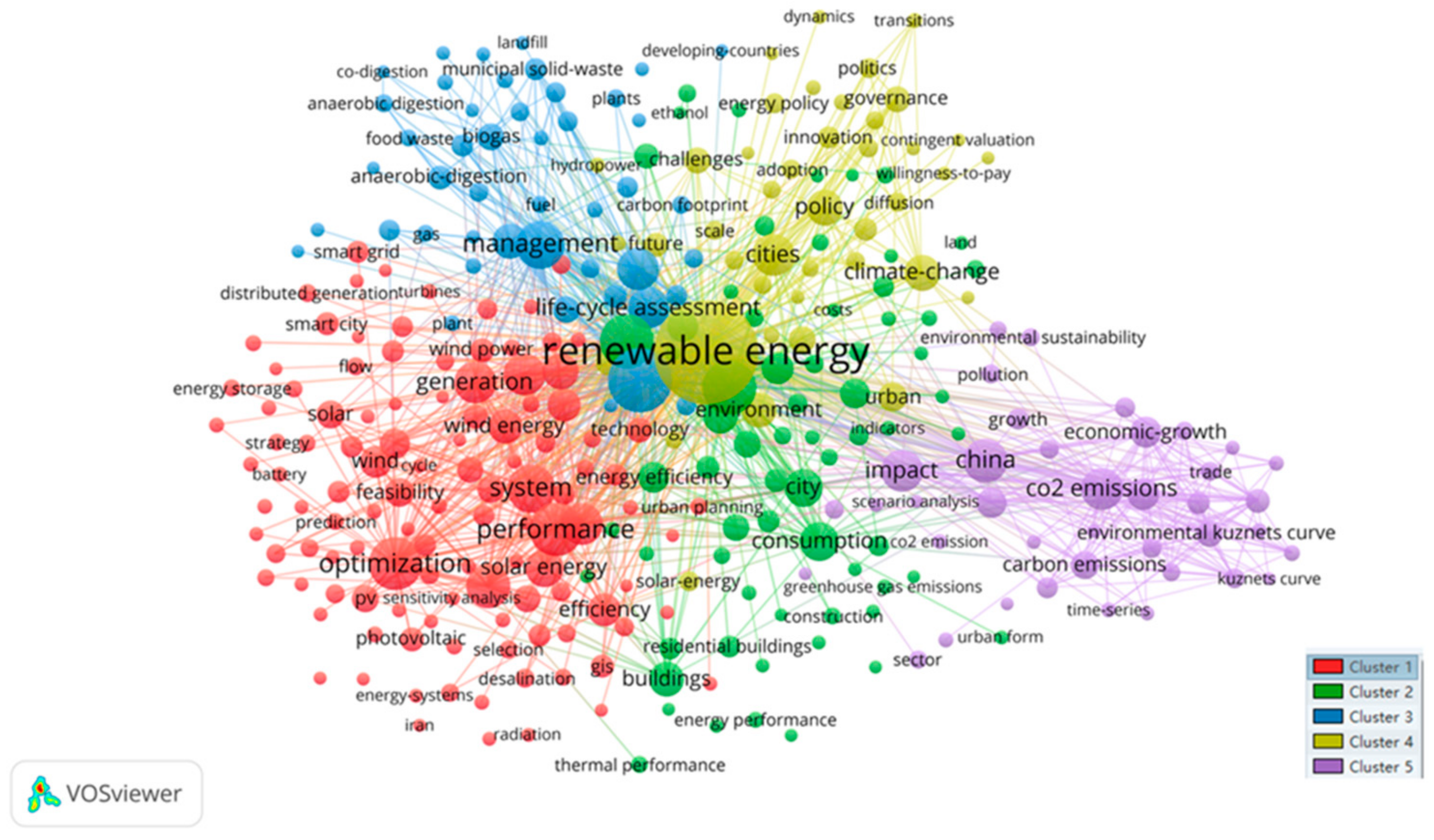Sustainable Development of Eco-Cities: A Bibliometric Review
Abstract
:1. Introduction
2. Methods
2.1. Bibliometric Analysis
2.2. Data Collection
2.3. Data Processing
3. Results
3.1. Evolution of the Sustainable Development of Eco-Cities (SDEC)
3.2. Main Areas of Study in SDEC Research
3.3. Main Authors of Study in SDEC Research
3.4. Main Countries of Study in SDEC Research
3.5. Main Institutions of Study in SDEC Research
3.6. Main Journals of Study in SDEC Research
3.7. Research Hotspots in SDEC Research
3.7.1. Sustainable Development of Eco-Cities and New Energy Utilization
3.7.2. Sustainable Development of Eco-Cities and Green Infrastructure
3.7.3. Sustainable Development of Eco-Cities and Urban Transformation
3.8. Frontier Trending in SDEC Research
4. Discussion
5. Conclusions
Author Contributions
Funding
Institutional Review Board Statement
Informed Consent Statement
Data Availability Statement
Conflicts of Interest
References
- The 2019 Revision of World Population Prospects. In The Twenty-Sixth Round of Official United Nations Population Estimates and Projections; United Nations: New York, NY, USA, 2019.
- Biello, D. Gigalopolises: Urban Land Area May Triple by 2030; Scientific American: New York, NY, USA, 2018; Volume 18. [Google Scholar]
- Kalmykova, Y.; Rosado, L.; Patrício, J. Resource consumption drivers and pathways to reduction: Economy, policy and lifestyle impact on material flows at the national and urban scale. J. Clean. Prod. 2016, 132, 70–80. [Google Scholar] [CrossRef] [Green Version]
- Wiedmann, T.; Chen, G.; Owen, A.; Lenzen, M.; Doust, M.; Barrett, J.; Steele, K. Three-scope carbon emission inventories of global cities. J. Ind. Ecol. 2020, 25, 735–750. [Google Scholar] [CrossRef]
- Muñiz, I.; Garcia-López, M. Urban form and spatial structure as determinants of the ecological footprint of commuting. Transp. Res. Part D Transp. Environ. 2019, 67, 334–350. [Google Scholar] [CrossRef]
- Ulucak, R.; Khan, S.U. Determinants of the ecological footprint: Role of renewable energy, natural resources, and urbanization. Sustain. Cities Soc. 2020, 54, 101996. [Google Scholar] [CrossRef]
- Bouchair, A.; Tebbouche, H.; Hammouni, A.; Lehtihet, M.C.; Blibli, M. Compact Cities as a Response to the Challenging Local Environmental Constraints in Hot Arid Lands of Algeria. Energy Procedia 2013, 42, 493–502. [Google Scholar] [CrossRef] [Green Version]
- Haarstad, H.; Kjærås, K.; Røe, P.G.; Tveiten, K. Diversifying the compact city: A renewed agenda for geographical research. Dialogues Hum. Geogr. 2022. [Google Scholar] [CrossRef]
- Wellmann, T.; Schug, F.; Haase, D.; Pflugmacher, D.; van der Linden, S. Green growth? On the relation between population density, land use and vegetation cover fractions in a city using a 30-years Landsat time series. Landsc. Urban Plan. 2020, 202, 103857. [Google Scholar] [CrossRef]
- Huang, X.; Song, J.; Wang, C.; Chui, T.F.M.; Chan, P.W. The synergistic effect of urban heat and moisture islands in a compact high-rise city. Build. Environ. 2021, 205, 108274. [Google Scholar] [CrossRef]
- Benavides, J.; Guevara, M.; Snyder, M.G.; Rodríguez-Rey, D.; Soret, A.; Pérez García-Pando, C.; Jorba, O. On the impact of excess diesel NOX emissions upon NO2 pollution in a compact city. Environ. Res. Lett. 2021, 16, 024024. [Google Scholar] [CrossRef]
- Facchini, A.; Kennedy, C.; Stewart, I.; Mele, R. The energy metabolism of megacities. Appl. Energy 2017, 186, 86–95. [Google Scholar] [CrossRef]
- Register, R. Ecocity Berkeley: Building Cities for a Healthy Future; North Atlantic Books: Berkeley, CA, USA, 1987. [Google Scholar]
- Diamantini, C.; Zanon, B. Planning the urban sustainable development the case of the plan for the province of Trento, Italy. Environ. Impact Assess. Rev. 2000, 20, 299–310. [Google Scholar] [CrossRef]
- Kondratyev, S. A system for ecological and economic assessment. Water Resour. Syst. Hydrol. Risk Manag. Dev. 2003, 278, 327. [Google Scholar]
- Teixeira, C.P.; Fernandes, C.O.; Ahern, J.; Honrado, J.P.; Farinha-Marques, P. Urban ecological novelty assessment: Implications for urban green infrastructure planning and management. Sci. Total Environ. 2021, 773, 145121. [Google Scholar] [CrossRef] [PubMed]
- Xu, Z.; Yin, Y. Regional Development Quality of Yangtze River Delta: From the Perspective of Urban Population Agglomeration and Ecological Efficiency Coordination. Sustainability 2021, 13, 12818. [Google Scholar] [CrossRef]
- Ecocity Builders. Guidelines for Ecocity Development; Ecocity Builders: Oakland, CA, USA, 2015. [Google Scholar]
- Liu, L. A sustainability index with attention to environmental justice for eco-city classification and assessment. Ecol. Indic. 2018, 85, 904–914. [Google Scholar] [CrossRef]
- Wang, Y.; Ding, Q.; Zhuang, D. An eco-city evaluation method based on spatial analysis technology: A case study of Jiangsu Province, China. Ecol. Indic. 2015, 58, 37–46. [Google Scholar] [CrossRef]
- Kenworthy, J.R. The eco-city: Ten key transport and planning dimensions for sustainable city development. Environ. Urban. 2016, 18, 67–85. [Google Scholar] [CrossRef]
- Han, X.; Pei, J.; Liu, J.; Xu, L. Multi-objective building energy consumption prediction and optimization for eco-community planning. Energy Build. 2013, 66, 22–32. [Google Scholar] [CrossRef]
- Li, X.; Ma, X.; Hu, Z.; Li, S. Investigation of urban green space equity at the city level and relevant strategies for improving the provisioning in China. Land Use Policy 2021, 101, 105144. [Google Scholar] [CrossRef]
- Roula, F.; Bouchair, A. Application of the INDI Model of the HQE²R Approach to Assess the Sustainability of a Neighbourhood: Case of Jijel City in Algeria. Int. J. Built Environ. Sustain. 2021, 8, 63–75. [Google Scholar] [CrossRef]
- Venkatesh, G.; Chan, A.; Brattebø, H. Understanding the water-energy-carbon nexus in urban water utilities: Comparison of four city case studies and the relevant influencing factors. Energy 2014, 75, 153–166. [Google Scholar] [CrossRef]
- Maes, M.J.A.; Jones, K.E.; Toledano, M.B.; Milligan, B. Mapping synergies and trade-offs between urban ecosystems and the sustainable development goals. Environ. Sci. Policy 2019, 93, 181–188. [Google Scholar] [CrossRef]
- Diem, A.; Wolter, S. The Use of Bibliometrics to Measure Research Performance in Education Sciences. Res. High. Educ. 2012, 54, 86–114. [Google Scholar] [CrossRef] [Green Version]
- Mayr, P.; Scharnhorst, A. Scientometrics and information retrieval: Weak-links revitalized. Scientometrics 2014, 102, 2193–2199. [Google Scholar] [CrossRef] [Green Version]
- Abramo, G.; D’Angelo, C.; Viel, F. The field-standardized average impact of national research systems compared to world average: The case of Italy. Scientometr. 2011, 88, 599–615. [Google Scholar] [CrossRef]
- Ma, F.; Xi, M. Status and trends of bibliometric. J. Inf. Sci. 1992, 13, 7–17. [Google Scholar]
- Huang, X.; Gao, J.; Zhang, H. Low-carbon eco-city development policy in China: A bibliometric analysis of policy documents. Kybernetes 2022. [Google Scholar] [CrossRef]
- Li, I.; Commenges, H.; Bordignon, F.; Bonhomme, C.; Deroubaix, J.-F. The Tianjin Eco-City model in the academic literature on urban sustainability. J. Clean. Prod. 2019, 213, 259–274. [Google Scholar] [CrossRef] [Green Version]
- de Jong, M.; Joss, S.; Schraven, D.; Zhan, C.; Weijnen, M. Sustainable–smart–resilient–low carbon–eco–knowledge cities; making sense of a multitude of concepts promoting sustainable urbanization. J. Clean. Prod. 2015, 109, 25–38. [Google Scholar] [CrossRef] [Green Version]
- Rodrigues, M.; Franco, M. Bibliometric review about eco-cites and urban sustainable development: Trend topics. Environ. Dev. Sustain. 2022, 1–22. [Google Scholar] [CrossRef]
- Baker, N.C.; Ekins, S.; Williams, A.J.; Tropsha, A. A bibliometric review of drug repurposing. Drug Discov. Today 2018, 23, 661–672. [Google Scholar] [CrossRef] [PubMed]
- Kamalski, J.; Kirby, A. Bibliometrics and urban knowledge transfer. Cities 2012, 29, S3–S8. [Google Scholar] [CrossRef]
- Ding, X.; Yang, Z. Knowledge mapping of platform research: A visual analysis using VOSviewer and CiteSpace. Electron. Commer. Res. 2020. [Google Scholar] [CrossRef]
- Tu, Y. Urban debates for climate change after the Kyoto Protocol. Urban Stud. 2017, 55, 3–18. [Google Scholar] [CrossRef] [Green Version]
- Chen, L.; Xu, L.; Cai, Y.; Yang, Z. Spatiotemporal patterns of industrial carbon emissions at the city level. Resour. Conserv. Recycl. 2021, 169, 105499. [Google Scholar] [CrossRef]
- Kammen, D.M.; Sunter, D.A. City-integrated renewable energy for urban sustainability. Science 2016, 352, 6922–6928. [Google Scholar] [CrossRef] [Green Version]
- Singh, K.; Hachem-Vermette, C. Economical energy resource planning to promote sustainable urban design. Renew. Sustain. Energy Rev. 2021, 137, 110619. [Google Scholar] [CrossRef]
- Zaman, D.; Tiwari, M.K.; Gupta, A.K.; Sen, D. Performance indicators-based energy sustainability in urban water distribution networks: A state-of-art review and conceptual framework. Sustain. Cities Soc. 2021, 72, 103036. [Google Scholar] [CrossRef]
- Mörtberg, U.; Goldenberg, R.; Kalantari, Z.; Kordas, O.; Deal, B.; Balfors, B.; Cvetkovic, V. Integrating ecosystem services in the assessment of urban energy trajectories—A study of the Stockholm Region. Energy Policy 2017, 100, 338–349. [Google Scholar] [CrossRef]
- McBain, B.; Lenzen, M.; Albrecht, G.; Wackernagel, M. Reducing the ecological footprint of urban cars. Int. J. Sustain. Transp. 2017, 12, 117–127. [Google Scholar] [CrossRef]
- Topi, C.; Esposto, E.; Marini Govigli, V. The economics of green transition strategies for cities: Can low carbon, energy efficient development approaches be adapted to demand side urban water efficiency? Environ. Sci. Policy 2016, 58, 74–82. [Google Scholar] [CrossRef]
- Hu, J.; Wu, J.; Zhao, C.; Wang, P. Challenges for China to achieve carbon neutrality and carbon peak goals: Beijing case study. PLoS ONE 2021, 16, e0258691. [Google Scholar] [CrossRef] [PubMed]
- Huang, C.K.; Neylon, C.; Hosking, R.; Montgomery, L.; Wilson, K.S.; Ozaygen, A.; Brookes-Kenworthy, C. Evaluating the impact of open access policies on research institutions. eLife 2020, 9, e57067. [Google Scholar] [CrossRef] [PubMed]
- de Mello Santos, V.H.; Campos, T.L.R.; Espuny, M.; de Oliveira, O.J. Towards a green industry through cleaner production development. Environ. Sci. Pollut. Res. Int. 2022, 29, 349–370. [Google Scholar] [CrossRef]
- Oliveira Neto, G.C.d.; Cesar da Silva, P.; Tucci, H.N.P.; Amorim, M. Reuse of water and materials as a cleaner production practice in the textile industry contributing to blue economy. J. Clean. Prod. 2021, 305, 127075. [Google Scholar] [CrossRef]
- Charmondusit, K.; Gheewala, S.H.; Mungcharoen, T. Green and sustainable innovation for cleaner production in the Asia-Pacific region. J. Clean. Prod. 2016, 134, 443–446. [Google Scholar] [CrossRef]
- Annibaldi, V.; Cucchiella, F.; De Berardinis, P.; Gastaldi, M.; Rotilio, M. An integrated sustainable and profitable approach of energy efficiency in heritage buildings. J. Clean. Prod. 2020, 251, 119516. [Google Scholar] [CrossRef]
- GhaffarianHoseini, A.; Dahlan, N.D.; Berardi, U.; GhaffarianHoseini, A.; Makaremi, N.; GhaffarianHoseini, M. Sustainable energy performances of green buildings: A review of current theories, implementations and challenges. Renew. Sustain. Energy Rev. 2013, 25, 1–17. [Google Scholar] [CrossRef]
- Dwaikat, L.N.; Ali, K.N. Green buildings cost premium: A review of empirical evidence. Energy Build. 2016, 110, 396–403. [Google Scholar] [CrossRef]
- Kadarwanto, H.H.; Latief, Y.; Machfudiyanto, R.A. Development of maintenance information systems for landscape and housekeeping components for state green buildings based on state building maintenance guidelines. In IOP Conference Series: Materials Science and Engineering; IOP Publishing: Bristol, UK, 2020; Volume 830, p. 022051. [Google Scholar] [CrossRef]
- Mulya, K.S.; Zhou, J.; Phuang, Z.X.; Laner, D.; Woon, K.S. A systematic review of life cycle assessment of solid waste management: Methodological trends and prospects. Sci. Total Environ. 2022, 831, 154903. [Google Scholar] [CrossRef]
- Mazzucco, W.; Costantino, C.; Restivo, V.; Alba, D.; Marotta, C.; Tavormina, E.; Cernigliaro, A.; Macaluso, M.; Cusimano, R.; Grammauta, R.; et al. The Management of Health Hazards Related to Municipal Solid Waste on Fire in Europe: An Environmental Justice Issue? Int. J. Environ. Res. Public Health 2020, 17, 6617. [Google Scholar] [CrossRef] [PubMed]
- Hanif, I. Impact of fossil fuels energy consumption, energy policies, and urban sprawl on carbon emissions in East Asia and the Pacific: A panel investigation. Energy Strategy Rev. 2018, 21, 16–24. [Google Scholar] [CrossRef]
- Grafakos, S.; Viero, G.; Reckien, D.; Trigg, K.; Viguie, V.; Sudmant, A.; Graves, C.; Foley, A.; Heidrich, O.; Mirailles, J.M.; et al. Integration of mitigation and adaptation in urban climate change action plans in Europe: A systematic assessment. Renew. Sustain. Energy Rev. 2020, 121, 109623. [Google Scholar] [CrossRef]
- Chai, K.C.; Li, Q.; Bao, X.L.; Zhu, J.; He, X.X. An Empirical Study of Economic Cycle, Air Quality, and National Health Since Reform and Opening Up. Front. Public Health 2021, 9, 706955. [Google Scholar] [CrossRef] [PubMed]
- Liang, L.; Chen, M.; Luo, X.; Xian, Y. Changes pattern in the population and economic gravity centers since the Reform and Opening up in China: The widening gaps between the South and North. J. Clean. Prod. 2021, 310, 127379. [Google Scholar] [CrossRef]
- Qiao, X. A Reflection on the Transformation of the Economic Development Model in China. In Proceedings of the 2017 International Conference on Humanities Science, Management and Education Technology (HSMET 2017), Taiyuan, China, 25–26 February 2017; Volume 173, pp. 930–935. [Google Scholar]
- Lee, C.T.; Lim, J.S.; Fan, Y.V.; Liu, X.; Fujiwara, T.; Klemeš, J.J. Enabling low-carbon emissions for sustainable development in Asia and beyond. J. Clean. Prod. 2018, 176, 726–735. [Google Scholar] [CrossRef]
- Freitas, S.; Catita, C.; Redweik, P.; Brito, M.C. Modelling solar potential in the urban environment: State-of-the-art review. Renew. Sustain. Energy Rev. 2015, 41, 915–931. [Google Scholar] [CrossRef]
- Martins, T.A.; Adolphe, L.; Bastos, L.E. From solar constraints to urban design opportunities: Optimization of built form typologies in a Brazilian tropical city. Energy Build. 2014, 76, 43–56. [Google Scholar] [CrossRef]
- Sarralde, J.J.; Quinn, D.J.; Wiesmann, D.; Steemers, K. Solar energy and urban morphology: Scenarios for increasing the renewable energy potential of neighbourhoods in London. Renew. Energy 2015, 73, 10–17. [Google Scholar] [CrossRef] [Green Version]
- Nasrollahi, N.; Shokri, E. Daylight illuminance in urban environments for visual comfort and energy performance. Renew. Sustain. Energy Rev. 2016, 66, 861–874. [Google Scholar] [CrossRef]
- Huide, F.; Xuxin, Z.; Lei, M.; Tao, Z.; Qixing, W.; Hongyuan, S. A comparative study on three types of solar utilization technologies for buildings: Photovoltaic, solar thermal and hybrid photovoltaic/thermal systems. Energy Convers. Manag. 2017, 140, 1–13. [Google Scholar] [CrossRef]
- Mohajeri, N.; Upadhyay, G.; Gudmundsson, A.; Assouline, D.; Kämpf, J.; Scartezzini, J.-L. Effects of urban compactness on solar energy potential. Renew. Energy 2016, 93, 469–482. [Google Scholar] [CrossRef] [Green Version]
- Jones, S.; Somper, C. The role of green infrastructure in climate change adaptation in London. Geogr. J. 2014, 180, 191–196. [Google Scholar] [CrossRef]
- Pulighe, G.; Fava, F.; Lupia, F. Insights and opportunities from mapping ecosystem services of urban green spaces and potentials in planning. Ecosyst. Serv. 2016, 22, 1–10. [Google Scholar] [CrossRef]
- Liu, O.Y.; Russo, A. Assessing the contribution of urban green spaces in green infrastructure strategy planning for urban ecosystem conditions and services. Sustain. Cities Soc. 2021, 68, 102772. [Google Scholar] [CrossRef]
- Ureta, J.; Motallebi, M.; Scaroni, A.E.; Lovelace, S.; Ureta, J.C. Understanding the public’s behavior in adopting green stormwater infrastructure. Sustain. Cities Soc. 2021, 69, 102815. [Google Scholar] [CrossRef]
- Miller, S.M.; Montalto, F.A. Stakeholder perceptions of the ecosystem services provided by Green Infrastructure in New York City. Ecosyst. Serv. 2019, 37, 100928. [Google Scholar] [CrossRef]
- Meerow, S.; Newell, J.P. Spatial planning for multifunctional green infrastructure: Growing resilience in Detroit. Landsc. Urban Plan. 2017, 159, 62–75. [Google Scholar] [CrossRef]
- Demuzere, M.; Orru, K.; Heidrich, O.; Olazabal, E.; Geneletti, D.; Orru, H.; Bhave, A.G.; Mittal, N.; Feliu, E.; Faehnle, M. Mitigating and adapting to climate change: Multi-functional and multi-scale assessment of green urban infrastructure. J. Environ. Manag. 2014, 146, 107–115. [Google Scholar] [CrossRef]
- Chen, W.Y. The role of urban green infrastructure in offsetting carbon emissions in 35 major Chinese cities: A nationwide estimate. Cities 2015, 44, 112–120. [Google Scholar] [CrossRef]
- Abdulateef, M.F.; Al-Alwan, H.A. The effectiveness of urban green infrastructure in reducing surface urban heat island. Ain Shams Eng. J. 2022, 13, 101526. [Google Scholar] [CrossRef]
- Hu, M.-C.; Wadin, J.L.; Lo, H.-C.; Huang, J.-Y. Transformation toward an eco-city: Lessons from three Asian cities. J. Clean. Prod. 2016, 123, 77–87. [Google Scholar] [CrossRef]
- Dong, H.; Fujita, T.; Geng, Y.; Dong, L.; Ohnishi, S.; Sun, L.; Dou, Y.; Fujii, M. A review on eco-city evaluation methods and highlights for integration. Ecol. Indic. 2016, 60, 1184–1191. [Google Scholar] [CrossRef]
- Gingrich, S.; Haidvogl, G.; Krausmann, F. The Danube and Vienna: Urban resource use, transport and land use 1800–1910. Reg. Environ. Change 2011, 12, 283–294. [Google Scholar] [CrossRef]
- Zinia, N.J.; McShane, P. Urban ecosystems and ecosystem services in megacity Dhaka: Mapping and inventory analysis. Urban Ecosyst. 2021, 24, 915–928. [Google Scholar] [CrossRef]
- Bahgat, R.; Reffat, R.M.; Elkady, S.L. Analyzing the impact of design configurations of urban features on reducing solar radiation. J. Build. Eng. 2020, 32, 101664. [Google Scholar] [CrossRef]
- Joss, S. Eco-cities: A global survey 2009. WIT Trans. Ecol. Environ. 2010, 129, 239–250. [Google Scholar] [CrossRef] [Green Version]
- Antuña-Rozado, C.; García-Navarro, J.; Huovila, P. Challenges in Adapting Sustainable City Solutions from Finland to Different Contexts Worldwide: A Libyan Case Study. Energies 2019, 12, 1883. [Google Scholar] [CrossRef] [Green Version]







| Period | Articles | Authors | Journals | Countries | Citations | Average Citations |
|---|---|---|---|---|---|---|
| 1990–1997 | 11 | 26 | 9 | 6 | 271 | 24.64 |
| 1998–2005 | 43 | 109 | 30 | 21 | 3059 | 71.14 |
| 2006–2013 | 254 | 804 | 130 | 55 | 12772 | 50.28 |
| 2014–2021 | 1556 | 5608 | 349 | 101 | 33934 | 21.81 |
| Total | 1864 | 6547 | 518 | 183 | 50036 | 26.84 |
| Rank | Author | Count | Citations | Average Citations/ Publication | Rank | Author | Count | Citations | Average Citations/ Publication |
|---|---|---|---|---|---|---|---|---|---|
| 1 | Huang, Guohe | 18 | 551 | 30.61 | 6 | Orehounig, Kristina | 7 | 733 | 104.71 |
| 2 | Duic, Neven | 11 | 223 | 20.27 | 7 | Yang, Hongxing | 7 | 301 | 43.00 |
| 3 | Senjyu, Tomonobu | 10 | 68 | 6.80 | 8 | Chen, Xin | 6 | 294 | 49.00 |
| 4 | Li, Yongping | 8 | 178 | 22.25 | 9 | Danish, Mir Sayed Shah | 6 | 51 | 8.50 |
| 5 | Mostafaeipour, Ali | 7 | 141 | 20.14 | 10 | Mavromatidis, Georgios | 6 | 517 | 86.17 |
| Rank | Country | Year | Count | Centrality | Rank | Country | Year | Count | Centrality |
|---|---|---|---|---|---|---|---|---|---|
| 1 | China | 1996 | 356 | 0.18 | 6 | Australia | 2007 | 92 | 0.07 |
| 2 | USA | 1994 | 236 | 0.17 | 7 | Germany | 1996 | 92 | 0.1 |
| 3 | Italy | 1996 | 160 | 0.09 | 8 | Spain | 2006 | 91 | 0.16 |
| 4 | England | 1992 | 123 | 0.23 | 9 | Canada | 1996 | 88 | 0.06 |
| 5 | Turkey | 2004 | 102 | 0.03 | 10 | Iran | 2008 | 85 | 0.08 |
| Rank | Institution | Year | Count | Centrality | Rank | Institution | Year | Count | Centrality |
|---|---|---|---|---|---|---|---|---|---|
| 1 | Beijing Normal University | 2009 | 32 | 0.05 | 6 | University of Tehran | 2008 | 19 | 0.03 |
| 2 | North China Electric Power University | 2015 | 29 | 0.07 | 7 | National University of Singapore | 2014 | 15 | 0.02 |
| 3 | Chinese Academy of Sciences | 2010 | 28 | 0.05 | 8 | Aalborg University | 2010 | 15 | 0.03 |
| 4 | Islamic Azad University | 2015 | 22 | 0.04 | 9 | University of Zagreb | 2016 | 14 | 0.03 |
| 5 | Hong Kong Polytechnic University | 2004 | 20 | 0.05 | 10 | University of Regina | 2009 | 13 | 0.00 |
| Rank | Journal | Articles | SJR(2020) | Country | JIF (2020) | Citations | OA |
|---|---|---|---|---|---|---|---|
| 1 | Journal of Cleaner Production | 135 | 1.937 (Q1) | USA | 9.297 | 4012 | No |
| 2 | Renewable & Sustainable Energy Reviews | 124 | 3.522 (Q1) | USA | 14.982 | 7737 | No |
| 3 | Sustainability | 103 | 0.612 (Q2) | Switzerland | 3.251 | 1108 | Yes |
| 4 | Energies | 92 | 0.598 (Q3) | Switzerland | 3.004 | 969 | Yes |
| 5 | Energy | 70 | 1.961 (Q1) | England | 7.147 | 2599 | No |
| 6 | Applied Energy | 69 | 3.035 (Q1) | England | 9.746 | 3900 | No |
| 7 | Renewable Energy | 68 | 1.825 (Q1) | England | 8.001 | 2350 | No |
| 8 | Energy Policy | 54 | 2.093 (Q1) | England | 6.142 | 2079 | No |
| 9 | Sustainable Cities and Society | 48 | 1.645 (Q1) | England | 7.587 | 877 | No |
| 10 | Energy Conversion and Management | 47 | 2.743 (Q1) | England | 9.709 | 1967 | No |
| Rank | Title | Year | Citations |
|---|---|---|---|
| 1 | Modelling solar potential in the urban environment: State-of-the-art review | 2015 | 29 |
| 2 | Environmental Accounting: EMERGY and Environmental Decision Making | 1996 | 29 |
| 3 | 4th Generation District Heating (4GDH) Integrating smart thermal grids into future sustainable energy systems | 2014 | 28 |
| 4 | City-integrated renewable energy for urban sustainability | 2016 | 24 |
| 5 | Geographies of energy transition: Space, place and the low-carbon economy | 2013 | 23 |
| 6 | Social perceptions about a technological innovation for fuelwood cooking: Case study in rural Mexico | 2007 | 23 |
| 7 | 2006. Environmental management—Life cycle assessment—Principles and framework | 2006 | 22 |
| 8 | CO2 emissions, economic growth, energy consumption, trade and urbanization in new EU member and candidate countries: A panel data analysis | 2015 | 21 |
| 9 | A review on buildings energy consumption information | 2008 | 21 |
| 10 | Solar energy and urban morphology: Scenarios for increasing the renewable energy potential of neighbourhoods in London | 2015 | 20 |
| Keywords | Year | Strength | Beginning | End | 1990–2021 |
|---|---|---|---|---|---|
| Sustainable development | 1990 | 3.37 | 1996 | 2007 |  |
| Sustainability | 1990 | 5.60 | 2009 | 2014 |  |
| Renewable energy | 1990 | 4.89 | 2009 | 2012 |  |
| Energy | 1990 | 6.35 | 2011 | 2013 |  |
| Future | 1990 | 3.95 | 2011 | 2012 |  |
| Policy | 1990 | 3.65 | 2011 | 2018 |  |
| Land use | 1990 | 3.85 | 2012 | 2015 |  |
| Bioenergy | 1990 | 3.35 | 2012 | 2018 |  |
| Urban metabolism | 1990 | 3.89 | 2014 | 2017 |  |
| Emission | 1990 | 4.51 | 2016 | 2017 |  |
| Tool | 1990 | 3.6 | 2016 | 2019 |  |
| Urban planning | 1990 | 3.48 | 2018 | 2019 |  |
| Ecosystem service | 1990 | 3.39 | 2018 | 2019 |  |
| Performance analysis | 1990 | 5.09 | 2019 | 2021 |  |
| Solar radiation | 1990 | 3.27 | 2019 | 2021 |  |
Publisher’s Note: MDPI stays neutral with regard to jurisdictional claims in published maps and institutional affiliations. |
© 2022 by the authors. Licensee MDPI, Basel, Switzerland. This article is an open access article distributed under the terms and conditions of the Creative Commons Attribution (CC BY) license (https://creativecommons.org/licenses/by/4.0/).
Share and Cite
Tang, W.; Niu, Z.; Wei, Z.; Zhu, L. Sustainable Development of Eco-Cities: A Bibliometric Review. Sustainability 2022, 14, 10502. https://doi.org/10.3390/su141710502
Tang W, Niu Z, Wei Z, Zhu L. Sustainable Development of Eco-Cities: A Bibliometric Review. Sustainability. 2022; 14(17):10502. https://doi.org/10.3390/su141710502
Chicago/Turabian StyleTang, Weiping, Zhengjia Niu, Zili Wei, and Liandong Zhu. 2022. "Sustainable Development of Eco-Cities: A Bibliometric Review" Sustainability 14, no. 17: 10502. https://doi.org/10.3390/su141710502
APA StyleTang, W., Niu, Z., Wei, Z., & Zhu, L. (2022). Sustainable Development of Eco-Cities: A Bibliometric Review. Sustainability, 14(17), 10502. https://doi.org/10.3390/su141710502






